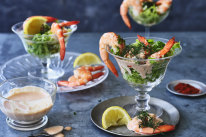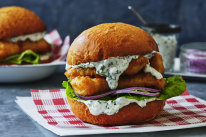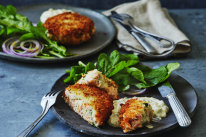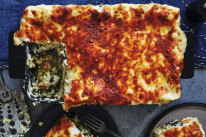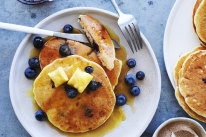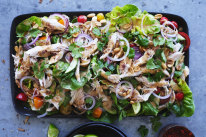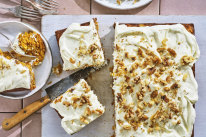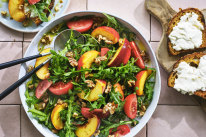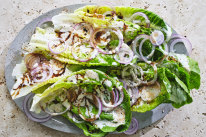Adam Liaw’s quick chicken curry: One master recipe, infinite spins
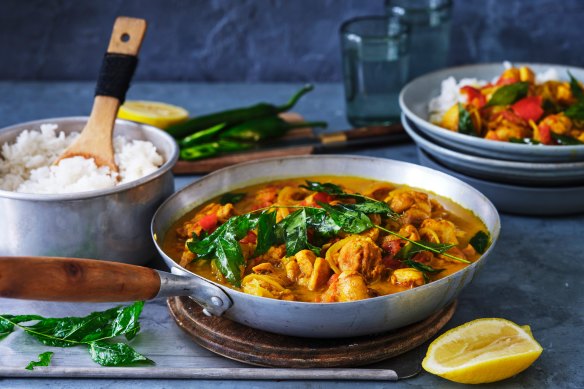
A family favourite, this recipe proves that not all curries are slow-braised, time-consuming adventures. And by following this basic method – but swapping out individual ingredients – you can adapt it into any number of distinct dishes (see tips).
Ingredients
2 tbsp vegetable oil
1 cinnamon stick
½ tsp yellow mustard seeds
10 curry leaves (optional)
2 onions, peeled and sliced
4 garlic cloves, roughly chopped
1cm piece of ginger, peeled and finely chopped
1 large green chilli, sliced
3 tsp ground cumin
2 tsp ground turmeric
2 tsp ground coriander
1 tsp salt
1kg chicken thigh fillets, cut into 5cm pieces
4 tomatoes, diced
200ml coconut milk
1 tsp garam masala
juice of ½ a lemon
steamed rice, to serve
Method
Step 1
Heat a large saucepan over medium heat and add the oil. Add the cinnamon and mustard seeds and stir until the seeds crackle, add the curry leaves if using (they will crackle too), then add the onions, garlic, ginger and chilli. Fry for about 3 minutes until softened and fragrant, then add the cumin, turmeric, coriander and salt, and stir well.
Step 2
Add the chicken and stir to coat in the spices. Add the tomatoes, coconut milk and about ½ a cup of water. Bring to a simmer then partially cover with a lid and cook gently, stirring occasionally, for 15 minutes until the chicken is cooked through and the curry is fragrant.
Step 3
Stir through the garam masala and simmer for a further 3 minutes, then stir through lemon juice to taste. Serve with steamed rice.
Tips
The purists will quite rightly tell you there is no such thing in subcontinental cuisines as “curry”. But as a generic term to encompass richly spiced, gravy-based dishes, it is a useful shorthand for those of us who struggle to know our korma (a braised dish of Mughal origin, often made with yoghurt and sometimes ground nuts) from our rogan josh (a richly aromatic, red, meat-based dish characterised by the separation of “rogan” oil during the “josh” braising process).
Here’s a primer on how a “curry” can come together.
Regional cuisines
I find the cuisines of the Indian subcontinent absolutely fascinating. There are thousands of dishes with infinite twists. A particular region might make a biryani a completely different way from another, and even within a region different ethnic groups will have their own special ways of making it.
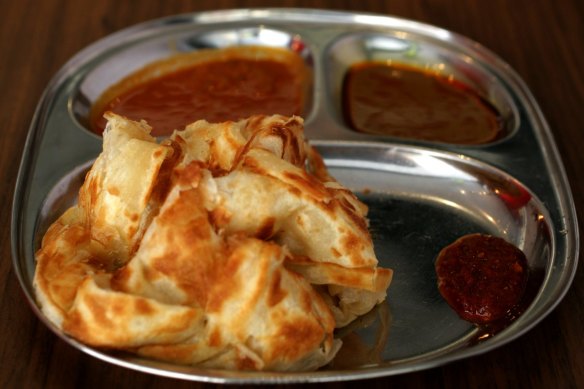
I am certainly no expert, but there are some (very) rough generalisations we can make. To the north, dishes are more Arab-influenced; often less spicy than in the south; favour ground spices and the fragrant spice mix garam masala; and are served with breads such as naan and roti. In the south, whole spices, coconut and tamarind are used more frequently, and dishes are often more liquid and intended to be eaten with rice.
My quick curry is not an authentic recreation of any particular regional dish, but instead combines techniques and ingredients from both north and south.
Components of a “curry”
You can broadly divide a curry into four components: an aromatic base, spices, a main ingredient and liquid.
- The base will usually be a combination of onion, garlic and ginger, either chopped or pureed.
- The spices can vary hugely, but in this case I have used cumin, turmeric, coriander, mustard seeds and garam masala.
- The main ingredient can be vegetables, pulses, meat or fish, and the cooking time of your curry will vary accordingly.
- The liquid can be a dairy product such as yoghurt or cream, coconut cream, stock, water or even vegetables (such as tomatoes or spinach puree). You can, of course, combine different liquids (in this dish, for example, I’ve used tomatoes, coconut milk and water).
To these four basic components, you could also add two components for further nuance: a souring agent such as citrus juice, green mango powder, tamarind or vinegar to balance the taste of the curry, and an oil (e.g. coconut oil, vegetable oil, mustard oil, ghee), which is very important in Indian cuisines.
Mentally separating a curry into its four key components drastically simplifies the cooking process: Fry the aromatic base in oil, add spices, add the main ingredient and liquid, then braise until cooked.
Then, by moving the components around, you see how easily you can create an incredible variety of “curries”. Change the aromatics, the spices, the main ingredient or the liquid, and you can make thousands upon thousands of distinctive dishes.
Spices and tadka
Despite having grown up eating curries of all stripes, the one thing that helped me understand “curries” better was when a friend gave me a masala dabba (a container for holding spices) that wasn’t labelled. Instead of following a prescribed formula and proportion of spices, I needed to smell each spice and add it for the specific aroma it provided. A little more of this, a little less of that and all of a sudden each of my dishes took on individual characteristics.
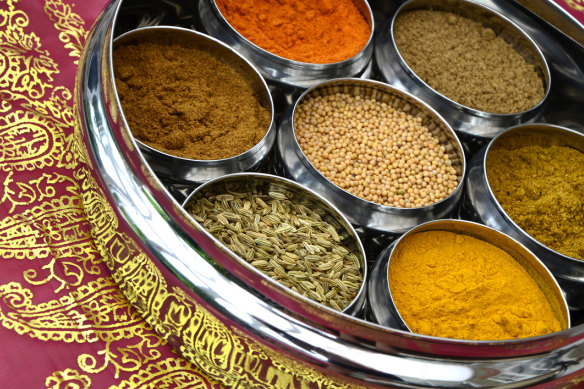
One important part of using spices is tadka (also called chauk or chaunk in different languages). This is the process of frying spices in hot oil to release their aromas. It is often done at the end of cooking, where spices separately fried in oil are poured over the dish, adding richness, flavour and aroma, but it can also be done at the start of cooking as in this recipe, where the mustard seeds, curry leaves and cinnamon are fried first, then the ground spices are added and fried before adding the chicken.
One departure from the general rule of frying spices is garam masala, which is often added toward the end of cooking for the fresh aromatics of the mixed spices, though it can also be added earlier and fried together with the other spices.
Appears in these collections
- Adam Liaw’s masterclass is in session: Five comforting winter classics every cook should know
- Keep calm and curry on: Good Food’s 50 most popular recipes of 2023
- All killer, no filler: Good Food’s 50 most popular recipes of 2023 (so far)
- Good Food’s 10 most popular recipes of autumn (starring RecipeTin Eats’ record-breaking chicken curry)
- Winner winner midweek chicken dinners: 15 fast, easy and economical recipes
The best recipes from Australia's leading chefs straight to your inbox.
Sign upFrom our partners
Similar Recipes

Adam Liaw’s step-by-step guide to making the perfect chicken parmigiana at home
- 30 mins - 1 hr
- Adam Liaw
More by Adam Liaw
Original URL: https://www.smh.com.au/goodfood/recipes/adam-liaw-s-quick-chicken-curry-one-master-recipe-infinite-spins-20230411-p5czjr.html

